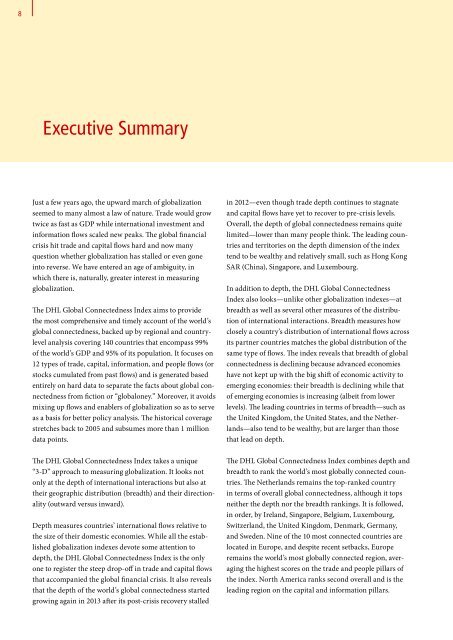DHL Global Connectedness Index 2014
DHL Global Connectedness Index 2014
DHL Global Connectedness Index 2014
- No tags were found...
You also want an ePaper? Increase the reach of your titles
YUMPU automatically turns print PDFs into web optimized ePapers that Google loves.
8<br />
Executive Summary<br />
Just a few years ago, the upward march of globalization<br />
seemed to many almost a law of nature. Trade would grow<br />
twice as fast as GDP while international investment and<br />
information flows scaled new peaks. The global financial<br />
crisis hit trade and capital flows hard and now many<br />
question whether globalization has stalled or even gone<br />
into reverse. We have entered an age of ambiguity, in<br />
which there is, naturally, greater interest in measuring<br />
globalization.<br />
The <strong>DHL</strong> <strong>Global</strong> <strong>Connectedness</strong> <strong>Index</strong> aims to provide<br />
the most comprehensive and timely account of the world’s<br />
global connectedness, backed up by regional and countrylevel<br />
analysis covering 140 countries that encompass 99%<br />
of the world’s GDP and 95% of its population. It focuses on<br />
12 types of trade, capital, information, and people flows (or<br />
stocks cumulated from past flows) and is generated based<br />
entirely on hard data to separate the facts about global connectedness<br />
from fiction or “globaloney.” Moreover, it avoids<br />
mixing up flows and enablers of globalization so as to serve<br />
as a basis for better policy analysis. The historical coverage<br />
stretches back to 2005 and subsumes more than 1 million<br />
data points.<br />
The <strong>DHL</strong> <strong>Global</strong> <strong>Connectedness</strong> <strong>Index</strong> takes a unique<br />
“3-D” approach to measuring globalization. It looks not<br />
only at the depth of international interactions but also at<br />
their geographic distribution (breadth) and their directionality<br />
(outward versus inward).<br />
Depth measures countries’ international flows relative to<br />
the size of their domestic economies. While all the established<br />
globalization indexes devote some attention to<br />
depth, the <strong>DHL</strong> <strong>Global</strong> <strong>Connectedness</strong> <strong>Index</strong> is the only<br />
one to register the steep drop-off in trade and capital flows<br />
that accompanied the global financial crisis. It also reveals<br />
that the depth of the world’s global connectedness started<br />
growing again in 2013 after its post-crisis recovery stalled<br />
in 2012—even though trade depth continues to stagnate<br />
and capital flows have yet to recover to pre-crisis levels.<br />
Overall, the depth of global connectedness remains quite<br />
limited—lower than many people think. The leading countries<br />
and territories on the depth dimension of the index<br />
tend to be wealthy and relatively small, such as Hong Kong<br />
SAR (China), Singapore, and Luxembourg.<br />
In addition to depth, the <strong>DHL</strong> <strong>Global</strong> <strong>Connectedness</strong><br />
<strong>Index</strong> also looks—unlike other globalization indexes—at<br />
breadth as well as several other measures of the distribution<br />
of international interactions. Breadth measures how<br />
closely a country’s distribution of international flows across<br />
its partner countries matches the global distribution of the<br />
same type of flows. The index reveals that breadth of global<br />
connectedness is declining because advanced economies<br />
have not kept up with the big shift of economic activity to<br />
emerging economies: their breadth is declining while that<br />
of emerging economies is increasing (albeit from lower<br />
levels). The leading countries in terms of breadth—such as<br />
the United Kingdom, the United States, and the Netherlands—also<br />
tend to be wealthy, but are larger than those<br />
that lead on depth.<br />
The <strong>DHL</strong> <strong>Global</strong> <strong>Connectedness</strong> <strong>Index</strong> combines depth and<br />
breadth to rank the world’s most globally connected countries.<br />
The Netherlands remains the top-ranked country<br />
in terms of overall global connectedness, although it tops<br />
neither the depth nor the breadth rankings. It is followed,<br />
in order, by Ireland, Singapore, Belgium, Luxembourg,<br />
Switzerland, the United Kingdom, Denmark, Germany,<br />
and Sweden. Nine of the 10 most connected countries are<br />
located in Europe, and despite recent setbacks, Europe<br />
remains the world’s most globally connected region, averaging<br />
the highest scores on the trade and people pillars of<br />
the index. North America ranks second overall and is the<br />
leading region on the capital and information pillars.





